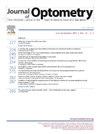Effect of a vergence-accommodation conflict induced during a 30-minute Virtual Reality game on vergence-accommodation parameters and related symptoms
IF 1.8
Q2 OPHTHALMOLOGY
引用次数: 0
Abstract
Purpose
The aim of the study was to verify the hypotheses that vergence-accommodation conflict (VAC) induced with head-mounted device (HMD) could cause symptoms in relation to changes in the accommodative-vergence system. In order to test this hypothesis, the Virtual Reality (VR) exposures were carried out in two types of VAC: VACsmall and VAClarge.
Method
Eighteen females, with a mean age of 22.5 ± 2.0 years, participated in two 30-minutes sessions with VR, which were separated by at least one week. Two sessions were differentiated by intensity of VAC presented in the VR system (VACsmall and VAClarge). Visual parameters were measured such as associated and dissociated phoria, accommodative response, the near point of convergence (NPC), fusional vergence ranges (FVR) and subjective complaints were measured using Simulator Sickness Questionnaire (SSQ). The parameters were measured immediately before (Pre-test) and after (Post-test) the VR exposure.
Results
The subjective symptoms as nausea, oculomotor disorders and disorientation increased significantly after 30-minutes of exposure on VAClarge (P<0.05). The associated and dissociated phoria, lag of accommodation, FVR and the NPC did not significantly change after the VR exposure (P>0.05).
Conclusion
Short-term use of HMD (30-min) did not significantly affect accommodative-vergence functions regardless of the size of VAC (VACsmall and VAClarge). However, the level of symptoms increased after VR sessions, which was probably related to inappropriate oculo-vestibular relationship.
在 30 分钟的虚拟现实游戏中诱发的辐辏适应冲突对辐辏适应参数和相关症状的影响。
目的:本研究旨在验证以下假设:使用头戴式设备(HMD)引起的辐辏-适应冲突(VAC)可能导致与辐辏-适应系统变化有关的症状。为了验证这一假设,我们在两种类型的 VAC(VAC 小和 VAC 大)中进行了虚拟现实(VR)暴露:平均年龄为 22.5 ± 2.0 岁的 18 名女性参加了两次 30 分钟的虚拟现实训练,两次训练至少间隔一周。两节课以 VR 系统中呈现的 VAC 强度(VAC 小和 VAC 大)来区分。测量了视觉参数,如相关和分离幻视、适应反应、近辐辏点(NPC)、融合辐辏范围(FVR),并使用模拟器晕机问卷(SSQ)测量了主观感觉。这些参数分别在模拟器暴露前(前测)和暴露后(后测)进行测量:结果:在 VAClarge 上暴露 30 分钟后,恶心、眼球运动障碍和迷失方向等主观症状明显增加(P0.05):结论:无论 VAC 大小(VAC 小和 VAC 大)如何,短期使用 HMD(30 分钟)对适应-辐辏功能均无明显影响。然而,VR 治疗后症状水平有所上升,这可能与不恰当的眼-前庭关系有关。
本文章由计算机程序翻译,如有差异,请以英文原文为准。
求助全文
约1分钟内获得全文
求助全文

 求助内容:
求助内容: 应助结果提醒方式:
应助结果提醒方式:


